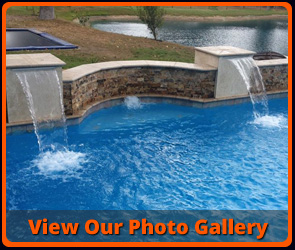Did you know that there are over 10 million pools in the United States? And there’s a reason why — owning a pool is a dream for any homeowner. Summer days become so much better and your guests will love coming over and swimming in your pool. This is especially true in Texas; there’s nothing better than taking a dip in the pool on a warm summer day!
If you’re planning a custom pool, you’ll first want to consider pool design. Here’s your guide to the entire process.
Pool Design Factors to Consider
When it comes to pool design, you’ll want to plan each individual characteristic before looking at the bigger picture. Plan these details out alone or with your pool designer.
Shape
Pools don’t have to be round. Your pool can be all shapes, depending on your aesthetic and what works best with your backyard pool designs. You’ll also want to consider any landscaping you already have. We will discuss pool landscaping more in another section.
Certain pool shapes also give off a specific appeal. For example, modern pool designs typically have a square or rectangular pool. Circular pools are more traditional.
The best quality about pool design is you have lots of freedom choosing the shape — you’re not restricted to specific geometric designs. Some popular unique pool shapes are figure-8, L-shaped, Roman, Grecian, infinity, and more.
Size
No matter the shape you choose, you’ll want to ensure the pool fits in your backyard. That’s why size is another one of the most important factors to consider. While it’s common sense, if you have a small backyard, you should build a smaller pool.
Size also encompasses more than backyard size. Consider how many people will be using your pool. Will you have many guests over constantly? Or will you and your family be the main ones using the pool? The more people who use your pool, the bigger you should plan it.
Functionality is also a main aspect to consider. Even if you don’t plan on throwing pool parties every weekend, you may need a larger pool if you engage in pool fitness.
Finally, we have cost. Pools are expensive, not only to build but also to maintain. The bigger your pool is, the more running expenses you’ll have to endure.
In-Ground or Above-Ground
There are two main pool types: in-ground and above-ground. Both come with their pros and cons. In-ground pools are the most popular and ones you’ll see most often in residential properties. They have a seamless aesthetic and are easy to dive into.
Above-ground pools are significantly more affordable than in-ground pools. Unfortunately, they don’t last as long and don’t have the seamless appeal that in-ground pools have. In addition, the ROI of an in-ground pool is better than an above-ground pool.
Placement
If you have a big backyard, you have more flexibility with your pool placement. But even if you have a small backyard, there are core placement rules you should follow.
First and foremost, place your pool in an area that gets a lot of sun. The sunlight helps maintain the ideal pool temperature. Placing your pool in the west or south of your backyard is usually a golden rule to ensure your pool attracts the most sunshine. However, your pool placement shouldn’t be somewhere that gets a lot of wind.
Privacy is also a big rule. You can easily enhance pool privacy by adding a fence and large plants. But if children are using the pool, you’ll need plenty of visibility in order to supervise them.
Keep in mind, if you have any sewers or storm drains located on your property, you’ll be limited with pool placement. It will also take longer for your permit to get approved by your local government.
Landscaping
Landscaping is one of the most vital pool design ideas. Landscaping refers to any plants and other essentials that are located around your pool.
First, choose your plants wisely. Ideally, pick low-maintenance plants. You’ll also want to avoid choosing plants and shrubs that give off a lot of debris. This means you’ll need to clean your pool more frequently. Large plants can also give you an extra layer of privacy.
If you’re planting flowers, understand that certain flowers bloom during specific periods. Opt for plants with long-lasting aesthetics, such as viburnum, vitex, Echinaceas, Shasta daisies, and catmint.
You may also want to add furniture items and even a new patio. Other core aspects of the pool landscaping include:
- Patio
- Lighting
- Outdoor kitchen
- Walls
- Pavilion
- Walkways
- Poolhouse
If you want any of these features, be sure to mention them to your pool designer and construction team.
Planning Your Pool
Once you have a general design idea for your pool, be sure to contact a pool designer.
The best pool designer has the experience to listen to your ideas and create a plan based on your vision. Understand that your pool design encompasses many decisions and it’s easy to be overwhelmed during the process. Expect a lot of back and forth between you and the designer.
The design process may also take as long as a few weeks before construction can even begin. As long as you have an excellent pool designer, they will help you throughout the process.
Pool Design Checklist
As stated previously, the design process is more in-depth and complicated. When homeowners are unsure about their pool design, it can cause serious delays. We compiled a handy checklist to make the design process easier:
- Have pool design inspiration (look at your friends’ pools, look at pictures and galleries, etc.)
- Set a pool size according to your needs and budget
- List all of the extra features you want
- Choose a theme (tropical, Grecian/Roman/Mediterranean, etc.)
- Think of safety features (UV protection, slip-resistant tiles, privacy, etc.)
- Choose a location
- Plan the landscaping
- Have pool storage options
Do You Need a Pool Design Professional?
As you can see, pool design is integral to the aesthetics and functionality of your pool. That’s why you’ll want to choose the best pool builder. We not only offer custom pool services but also other outdoor living features. Contact us today for a free consultation.




